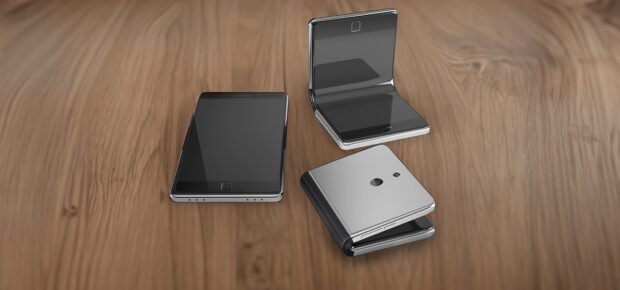August 14, 2024
For most of us, the televisions, laptops and smartphones we use have flat, rigid screens. That’s changing fast. Smartphone manufacturers, eager to roll out new features, have offered phones with foldable screens for a few years (though adoption has been lagging. Just 1% of smartphones sold are foldable.) The advertising industry uses flexible displays. And there’s an emerging class of wearable screens in healthcare used to monitor and diagnose patients.
Here, we discuss the technology behind the rise flexible screens.
A Little History
Flexible displays have been around for almost 50 years. The earliest relied on eInk, which displayed text in black and white. It’s the same technology used in e-readers. One advantage of this technology is that it consumes very little power.
Recent years have emphasized full-color displays capable of displaying video. Older flat-screen technology that supported this, like LCD displays, never lent itself well to bending.
“Newer OLED technologies are more tolerant of bending, and indeed, some commercially available flexible displays have made it to the marketplace,” said IEEE Life Fellow Stu Lipoff.
Materials Science
Driving the ability to make flexible, bending displays are materials science breakthroughs that allow for thinner and thinner screens. As this article from IEEE Spectrum explains, when something bends, the material on the inside of the bend is compressed, while the material on the outside is under tension.
The electronic components inside the device are also subject to those forces. However, a thinner screen creates less stress on the inside of the bend, making thinner materials more advantageous for phones with folding screens.
What Do You Mean By “Flexible”?
While flexible screens are making more and more appearances in consumer devices, there isn’t much clarity over what people mean when they use the word “flexible.”
- Foldable display don’t really fold like a piece of paper, nor do they have hinges. Instead, they are capable of creating a tight curve, making a “U” shape instead of a “V.” It’s commonly seen in smartphones that bend in half. It’s used to make devices more portable.
- Conformable displays can be bent to conform to a surface. Unlike foldable devices, however, they cannot be bent repeatedly. Think of screens inside an automobile that are curved to conform to a dashboard or smart watches that have a slight curve to conform to the user’s wrist.
- Rollable displays may not be able to manage the tight bending radius of a foldable device, but they wrap around a user’s wrist. Unlike conformable displays, rollable displays can be bent repeatedly. While several consumer electronics companies are working on rollable displays, they haven’t hit the mainstream market yet.
- Stretchable displays can extend or compress without breaking. Some are in development for the consumer market. Simple stretchable displays with low resolution are also being integrated into medical device patches.
New Applications
Flexible screens aren’t just used in smartphones. They’re increasingly used in the medical field. Some are incorporated into devices that look like wristwatches but offer significantly more medical information. Screens can also be incorporated into patches that conform to the body.
“A flexible display will allow the display to conform to the mounted body part,” Lipoff said. “Wrist instruments today offer more than simple watch functions, including navigation and fitness monitors. More recently, biomedical sensors for temperature, blood oxygen, pulse, sugar and pressure have been introduced. Battery-operated medical patches are also being deployed to the skin for some of the same applications as wrist-mounted instruments but in a form that works better as a patch to deliver drugs metered by electronics.”
Lipoff said the screens on medical devices don’t need to have the full resolution of a smartphone. They just need to display a few pieces of important information.
“In such patch devices, a simple display to provide battery life and the level of fill of the medication adds value,” he said.
Learn more: IEEE Spectrum provides in-depth, ongoing coverage of the latest developments in flexible displays and stretchable electronics. Check out this story about stretchable batteries, or this one on a stretchable circuit that can read Braille, or this one about the increasing resolution of stretchable OLED patches.






 MEANINGFUL MOMENTUM OR RUNNING IN PLACE?
MEANINGFUL MOMENTUM OR RUNNING IN PLACE? AI Through Our Ages
AI Through Our Ages Liquid Infrastructure: Our Planet's Most Precious Resource
Liquid Infrastructure: Our Planet's Most Precious Resource The Impact of Technology in 2025
The Impact of Technology in 2025 Quantum and AI: Safeguards or Threats to Cybersecurity?
Quantum and AI: Safeguards or Threats to Cybersecurity? Why AI Can't Live Without Us
Why AI Can't Live Without Us Bits, Bytes, Buildings and Bridges: Digital-Driven Infrastructure
Bits, Bytes, Buildings and Bridges: Digital-Driven Infrastructure Impact of Technology in 2024
Impact of Technology in 2024 Emerging AI Cybersecurity Challenges and Solutions
Emerging AI Cybersecurity Challenges and Solutions The Skies are Unlimited
The Skies are Unlimited Smart Cities 2030: How Tech is Reshaping Urbanscapes
Smart Cities 2030: How Tech is Reshaping Urbanscapes Impact of Technology 2023
Impact of Technology 2023 Cybersecurity for Life-Changing Innovations
Cybersecurity for Life-Changing Innovations Smarter Wearables Healthier Life
Smarter Wearables Healthier Life Infrastructure In Motion
Infrastructure In Motion The Impact of Tech in 2022 and Beyond
The Impact of Tech in 2022 and Beyond Cybersecurity, Technology and Protecting Our World
Cybersecurity, Technology and Protecting Our World How Technology Helps us Understand Our Health and Wellness
How Technology Helps us Understand Our Health and Wellness The Resilience of Humanity
The Resilience of Humanity Harnessing and Sustaining our Natural Resources
Harnessing and Sustaining our Natural Resources Creating Healthy Spaces Through Technology
Creating Healthy Spaces Through Technology Exceptional Infrastructure Challenges, Technology and Humanity
Exceptional Infrastructure Challenges, Technology and Humanity The Global Impact of IEEE's 802 Standards
The Global Impact of IEEE's 802 Standards Scenes of our Cyber Lives: The Security Threats and Technology Solutions Protecting Us
Scenes of our Cyber Lives: The Security Threats and Technology Solutions Protecting Us How Millennial Parents are Embracing Health and Wellness Technologies for Their Generation Alpha Kids
How Millennial Parents are Embracing Health and Wellness Technologies for Their Generation Alpha Kids Space Exploration, Technology and Our Lives
Space Exploration, Technology and Our Lives Global Innovation and the Environment
Global Innovation and the Environment How Technology, Privacy and Security are Changing Each Other (And Us)
How Technology, Privacy and Security are Changing Each Other (And Us) Find us in booth 31506, LVCC South Hall 3 and experience the Technology Moon Walk
Find us in booth 31506, LVCC South Hall 3 and experience the Technology Moon Walk Virtual and Mixed Reality
Virtual and Mixed Reality How Robots are Improving our Health
How Robots are Improving our Health IEEE Experts and the Robots They are Teaching
IEEE Experts and the Robots They are Teaching See how millennial parents around the world see AI impacting the lives of their tech-infused offspring
See how millennial parents around the world see AI impacting the lives of their tech-infused offspring Take the journey from farm to table and learn how IoT will help us reach the rising demand for food production
Take the journey from farm to table and learn how IoT will help us reach the rising demand for food production Watch technical experts discuss the latest cyber threats
Watch technical experts discuss the latest cyber threats Explore how researchers, teachers, explorers, healthcare and medical professionals use immersive technologies
Explore how researchers, teachers, explorers, healthcare and medical professionals use immersive technologies Follow the timeline to see how Generation AI will be impacted by technology
Follow the timeline to see how Generation AI will be impacted by technology Learn how your IoT data can be used by experiencing a day in a connected life
Learn how your IoT data can be used by experiencing a day in a connected life Listen to technical experts discuss the biggest security threats today
Listen to technical experts discuss the biggest security threats today See how tech has influenced and evolved with the Games
See how tech has influenced and evolved with the Games Enter our virtual home to explore the IoT (Internet of Things) technologies
Enter our virtual home to explore the IoT (Internet of Things) technologies Explore an interactive map showcasing exciting innovations in robotics
Explore an interactive map showcasing exciting innovations in robotics Interactively explore A.I. in recent Hollywood movies
Interactively explore A.I. in recent Hollywood movies Get immersed in technologies that will improve patients' lives
Get immersed in technologies that will improve patients' lives